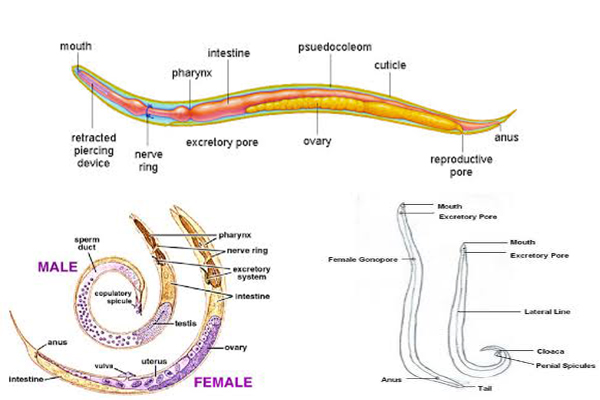General Characteristics of Phylum Nemathelminthes
General Characteristics of Phylum Nemathelminthes
Nemathelminthes or Aschelminthes
(Nematos- thread/ Askos- bladder, helminthes- worm)
- They are commonly called thread worm or round worm.
- It is a phylum of unsegmented, triploblastic, pseudocoelomic, cylindrical or thread-like worms which are covered by a body wall having cuticle and epidermis.
- Hyman regarded Aschelminthes as a distinct phylum and the various groups included in it as classes. However, other zoologists consider Aschelminthes as a superphylum and its various groups as phyla (Rotifera, Gastrotricha, Kinorhynca, Nematomorph, Nematoda). Phylum Nematoda is its large group.
General characters
- Mostly parasitic. Few of them are free-living.
- They are cylindrical, elongated, slender worm like and tapers at both end.
- Triploblastic.
- Bilaterally symmetrical.
- Organ system level of organization.
- Body is unsegmented.
- Body cavity is filled with muscle. They are pseudocoelomate i.e. body cavity is not lined by mesodermal layer.
- Internal cephalization is present but externally there is little differentiation between the anterior and posterior regions.
Distinct head is lacking. However, mouth is present in anterior region. - Body is covered with tough and resistant cuticle.
It is cast off periodically or which moults only during the period of growth.
It protects the body against the action of digestive juice. - Digestive system is complete and straight with both mouth and anus.
Mouth is terminal and surrounded by lips bearing sense organ. - Respiratory and circulatory organs are absent.
Respiration occurs through general body surface. Respiration is aerobic in free-living forms and anaerobic in parasitic form. - Excretory system consists of intracellular canal or lateral excretory ducts. And also protnephridia having renette cells.
- Nervous system is not much developed.
Nervous system consists of circumpharyngeal nerve ring and longitudinal nerve cords. - Sense organs are poorly developed in the form of papillae, which are well defined as amphids (in mouth) and phasmid (in anus).
- These are unisexual i.e. sexes are separate with sexual dimorphism.
- Fertilization is internal, may be cross or self.
- Development may be direct or indirect.
NOTE: Larval forms are Rhabditiform, Filariform and Micrifilaria. - Various lateral lines and pores are present on the surface of body.
Examples
| S.N. | Zoological name | Common name | Disease |
| 1 | Ascaris lumbricoides | Roundworm | Ascariasis. |
| 2 | Wuchereria bancrofti | Filarialworm | Elephantiasis |
| 3 | Enterobius vermicularis | Pin/thread worm | Churna |
| 4 | Loa loa | Eyeworm | conjunctivitis |
| 5 | Ancyclostoma duodenale | Hookworm | Ancyclostomiasis |
| 6 | Trichuris trichuria | Whipworm |
Classification
Phylum Nematod is classified into two classes on the basis of sensory organ.
| Aphasmida (Adenophora) | Phasmida (Secernetea) |
| Caudal sensory organs (Phasmid) are absent. | Phasmids are present. |
| Anterior sensory organs (Amphids) are of various types. | Amphids are pore like. |
| Usually free living. | Usually parasitic. |
| Excretory system absent or rudimentary. | Excretory system well developed with renette cells. |
| Tail is non-glandular. | Tail is glandular. |
| Examples: Trichinella, Dorylaimus | Examples: Ascaris lumbricoides, Enterobius vermicularis |
Things to Remember
- This is the first unisexual phylum.
- The tail is often curved in male.
- Amphids- are olfactoreceptors
- Phasmids- are chemoreceptors and glandulosensory.
- Resistant cuticle on the body surface is adaptation for its parasitic life.
- Cuticle secreted by underlying epidermis is composed of scleroprotein.
- No segmentation. In some, the cuticle is striated and thus giving the appearance of segmentation and called pseudo-segmentation.
- The pharynx is triradiate.
- Males are usually smaller than females.
- During development volume of cell increases (no increament in number of cells).
Ascaris lumbricoides
- Monogenetic life cycle, found in small intestine (jejunum) of man.
- Cause Ascariasis.
- Male Ascaris are monarchic or monodelphic (presence of single testis).
- Female are diorchic or didelphic (presence of pair of ovaries).
- In Ascaris, fertilization occurs in uterus.
- Moulting in life cycle occurs four times:
- 1st moulting- in soil
- 2nd and 3rd moulting- in lungs
- 4th moulting- in intestine.
2nd stage larva enters the lungs and 4th stage larva comes out of the lungs.
- Excretory organ is H-shaped.
- Mode of transmission- contaminated food and water.
- Infective stage- embryonated eggs with rhabditiform larva.
General Characteristics of Phylum Nemathelminthes
(Visited 104,217 times)


Kindly explain parasitic adaptation of ascaris!
More examples may be handy to explain the characterstics.